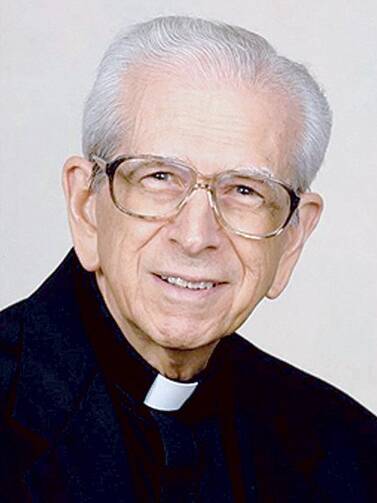Ernest Ferlita, S.J., a playwright and author, died in February. In 1996 America reviewed two of his plays, written 30 years apart, on Hiroshima and Nagasaki.
One of the better ways humans have found to contain and confront unspeakable suffering is to turn it into art. Few events in history so symbolize unspeakable suffering as the obliteration of Hiroshima and Nagasaki by atomic bomb. And as last year's bitter controversies over how to commemorate these events illustrate, artless words and political posturing do nothing but tear open old wounds. What was needed at that time was the cathartic power of art. Though it has come too late to affect that recent sorry spectacle, Two Cities, a remarkable staging of two one-act plays by Ernest Ferlita, a Jesuit priest and professor of drama at Loyola University in New Orleans, shows just how far art can go to touch those wounds and heal them. “Two Cities” is a production of Spectrum Stage Company, which is dedicated to the one-act play, and has just finished its run at the Thirtieth Street Theater in New York.
The two plays, written almost 30 years apart, are actually of a piece. Both are dramatic versions of the haiku, each little more than half an hour long and constructed with evocative images and tight design. Each has a narrator and a chorus of four, plus a few main characters telling focused stories of personal tragedy whose implications are universal.
The first of the plays, “The Bells of Nagasaki,” was written last year and is based on a book by Takashi Nagai, a Catholic physician whose wife was among the worshippers at the cathedral church in Nagasaki when the atomic bomb was detonated directly overhead. The plot of the play concerns the efforts of the surviving Catholics to raise the cathedral bells, buried intact under the rubble of the church. A comic aged parishioner, played by Mark Hattan, reports on the progress of the work, while Dr. Nagai (Gregory Zaragoza), dying of leukemia, attempts to convince his friend Ichitaro Yamada (Kazuki Takase), a soldier who came back only to find his family incinerated, that he should not flee the city and his nightmares but should stay and help with the project.
The dialogue between the two men, and the descriptions of the horror in Zen-like poetry and mime by the narrator (a striking young black woman whose real name is, appropriately, Novel Idea), by the chorus and by a little girl (played transparently by 11-year-old Lena Imamura) lead up to the exposition of Dr. Nagai's own novel idea. As Dr. Nagai sees it, there was a transcendent reason why the bomb exploded over the cathedral and not over a munitions plant: The people who were incinerated in the church and the surrounding area were a true holocaust, a burnt-offering to God in expiation for the sins of the human race that brought on both the war itself and the invention that ended it.
In real life, as in the play, Dr. Nagai delivered this message to the surviving Nagasaki Catholics on the site of the destroyed cathedral four months after the blast, and it was met, as was to be expected, with both anger and awe. The message condemns the masters of war of every country and promises them redemption at the same time. It is also a message that the controversialists of last summer desperately needed to hear.
The second play, “The Mask of Hiroshima,” written in the l960's by the then much younger Ferlita, deals not with mystic meanings but with the natural concerns of youth: love, marriage, family, hopes and dreams. But in Hiroshima after the bomb, these elemental wonders had to be seen through the grotesque mask of radiation that poisoned and disfigured a generation of young people. Here the archetypes are Hisa Ishikawa (acted with obvious personal involvement by the play's choreographer, Ako), her husband Shinji (Mr. Takase) and her father Okuma (Mr. Hattan). Seven years after the bomb, the couple is expecting a baby, but the effects of radiation threaten the mother's life and add the possibility of a sick or deformed child. Hisa's father encourages an abortion, but the very life of the next generation is at stake; Shinji himself now has cancer and does not expect to live long.
The hideous mask has many faces, too. Flashbacks of the couple's courtship shortly after the bomb reveal a once-beautiful woman disfigured by burns and scars and a handsome young man hobbled by a twisted leg. Each must overcome a mangled self-image and find the mutual beauty within. In the dreamlike climax, two monstrous Kabuki figures come to claim the fated mother, yet the play ends with a psalm of hope and praise.
His production is a harmonious mesh of setting, acting, dance and music. It has the elusive symmetry of a Zen garden. The performers, who donated their talents, brought out the best in Father Ferlita’s taut and poetic script, and Ken Lowstetter's direction was sober and forthright. The unadorned set of varnished wood panels and floor replicated the balanced interior of the traditional Japanese wooden house. The choreography, by Ako, had the economy and visual tension of Zen martial art. The music, composed and recorded on synthesizer by Yukio Tsuji, was versatile and powerfully effective. The contributions of the many Japanese members of the cast and design team to the integral beauty of this staging were obvious.
The impact of these two plays demonstrated the immense power of simplicity and meticulous crafting in the dramatic art. The impresarios of the current crop of sprawling Broadway extravaganzas would have had much to learn from viewing the Spectrum Stage Company's effort.








